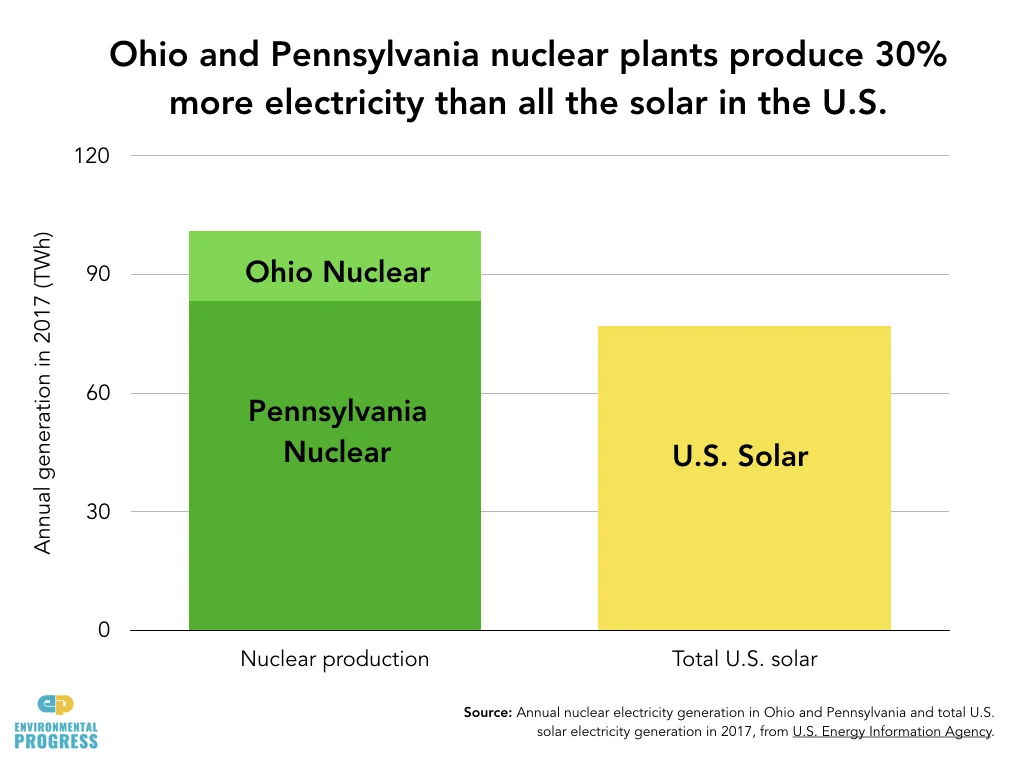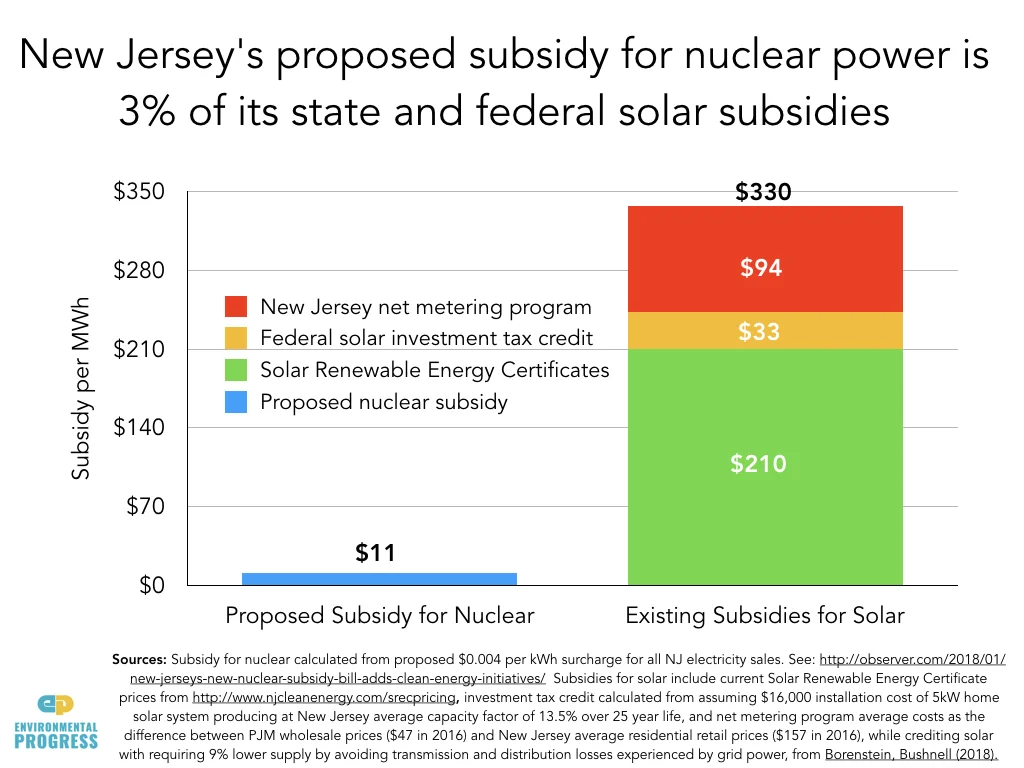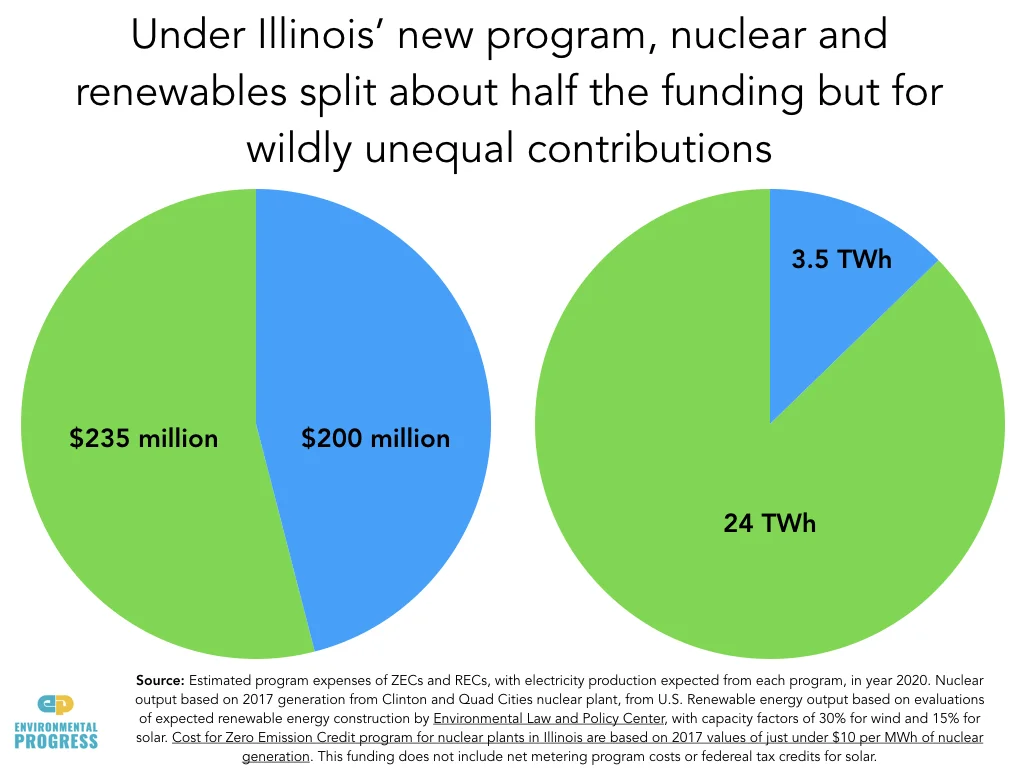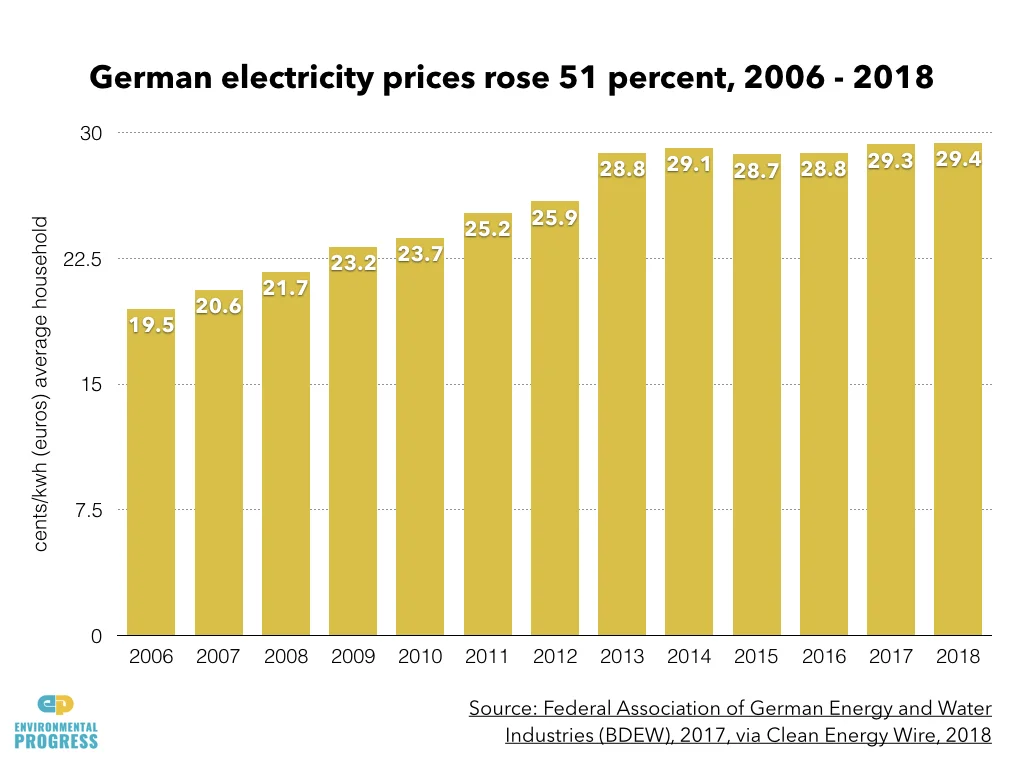Zero Dark Nuclear
Seven nuclear plants in Ohio and Pennsylvania produce 30 percent more power than all of the solar in the United States. If they are closed, the future of our largest source of clean energy is dark.
By Michael Shellenberger
If lawmakers fail to act soon, four nuclear plants in Ohio and Pennsylvania will be replaced with fossil fuels and emissions will rise the equivalent of adding six million cars to the road.
Three additional nuclear plants in Pennsylvania could be forced to close shortly after.
How much electricity is produced by the seven nuclear plants in Ohio and Pennsylvania? Thirty percent more than all of the solar energy produced in the United States in 2017.
The loss of those plants would constitute the single worst blow to nuclear energy since Germany decided to phase out its plants following the Fukushima accident in 2011.
Around the world, nuclear energy rests on a knife’s edge. Over the last two years, pro-nuclear advocates prevented nuclear phase-outs in South Korea, Illinois, New York, Connecticut, and France. But nuclear phase-outs are continuing elsewhere:
- Germany will likely see its emissions rise again this year thanks to its shuttering of a nuclear plant last December;
- California’s Lt. Governor Gavin Newsom led the secret effort to prematurely close the state’s last nuclear plant, Diablo Canyon — something even anti-nuclear advocates now admit will increase carbon emissions;
- In Japan and Taiwan, there are slow and halting efforts to re-open nuclear plants constantly frustrated by fear-mongering campaigns sometimes financed by renewable energy interests.
The U.S. has long been the global leader of nuclear energy. If we continue to allow nuclear plants to close, then we will cede nuclear energy globally to Russia and China and allow future energy demand to be met by fossil fuels.
A Dirty War
The anti-nuclear movement began its war on America’s largest source of clean energy by inciting a moral panic.
With the public confidence in government shaken by the Vietnam War and Watergate, anti-nuclear groups gained traction by claiming there was a conspiracy by electric utilities and government regulators to cover up the true dangers of nuclear plants.
The Sierra Club threw its full weight behind a fear-mongering campaign in Ohio where elected officials sought nuclear energy as a way to reduce deadly coal pollution. The San Francisco-based club sued, lobbied, twisted arms, and targeted mothers with hysterical fear-mongering.
"A nuclear accident could wipe out Cleveland,” Sierra Club ally Ralph Nader told an Ohio newspaper — lying flamboyantly — in 1974, “and the survivors would envy the dead."
"Our campaign stressing the hazards of nuclear power,” the then-Executive Director of the Sierra Club wrote in a confidential 1974 memo to the Board of Directors, “will supply a rationale for increasing regulation... and add to the cost of the industry.”
The groups all claimed at the time that rising energy efficiency meant electric utilities didn’t need to build new power plants of any kind.
But when electricity demand rose throughout the 1980s at nearly the same rate it had in the 1970s, anti-nuclear groups stood by and watched as coal plants were built instead.
An anti-nuclear Sierra Club leader later confessed to a historian, “I think playing dirty if you have a noble end is fine.”
Ohio and Pennsylvania today suffer from some of the worst air pollution in the country — pollution that will worsen if nuclear plants are closed.
Nuclear plants today provide 89 percent of Ohio’s electricity from clean energy sources, and 93 percent of Pennsylvania’s.
Today, Environmental Defense Fund (EDF), Natural Resources Defense Council (NRDC), and Sierra Club are working alongside the American Petroleum Institute (Big Oil & Natural Gas) to lobby against proposals to save nuclear plants in Ohio and Pennsylvania.
As such, EDF, NRDC, and Sierra Club have revealed themselves to be utterly unconcerned about increasing air pollution — and totally obsessed with killing our largest source of clean energy.
From Movement to Racket
EDF, NRDC, and Sierra Club denounce modest subsidies proposed to keep nuclear plants alive as a “bail-out” while quietly lobbying for far larger subsidies for wind and solar.
Consider that later this month, New Jersey’s legislature and governor may pass legislation to keep that state’s nuclear plants operating. If that happens, it will be the biggest victory for pro-nuclear forces since Connecticut’s governor and legislature took similar action late last year.
But it would come at a shockingly high price. Under the sway of NRDC, New Jersey’s newly elected governor is asking for $150 million more in subsidies per year by 2022 by increasing solar’s required contribution to New Jersey electricity from 4.1% to 5.1%.
In 2017, New Jersey ratepayers spent almost $600 million to generate just 2.8 terawatt-hours (TWh) of electricity from solar. By contrast, the proposed nuclear subsidy would cost $300 million per year to generate 28 TWh of electricity. And while the nuclear plants are paid only if market conditions require it, solar investors get paid no matter what.
New Jersey is not unique. In Illinois, ratepayers have been spending fifteen times more per unit of energy for Solar Renewable Energy Certificates than for nuclear’s new Zero Emission Certificates.
Under Illinois’s new program, a nuclear subsidy was combined with a much more costly renewables program. Compare nuclear’s $235 million per year for 24 TWh of electricity from nuclear to at least $200 million per year for just four TWh of electricity by 2020 from wind and solar under the new Renewable Portfolio Standard.
In New York, ratepayers will spend $482 million per year for 27 TWh of electricity from nuclear, at a rate of $17.48 per MWh. By contrast, New York and federal subsidies for rooftop solar are more than 10 times higher: $190 per MWh.
Indian Point, New York’s largest nuclear plant, needs no subsidy. It produces power for under $40 per MWh. And yet Gov. Cuomo has sought to shut it down at the urging of — you guessed it — the Sierra Club, NRDC, EDF, and a natural gas company implicated in the federal criminal prosecution of a Cuomo aide.
Indian Point’s replacement power is expected to come from new gas plants and renewables that typically cost $100 per MWh — and increase carbon emissions from electricity production by nearly 30 percent.
Never before has the famous quip — “Every great cause begins as a movement, becomes a business, and eventually degenerates into a racket” — seemed more true than it does today of the behavior of NRDC, EDF, and the Sierra Club.
Consider that:
- Sierra Club Foundation had on its board the founder and CEO of Sunrun, a company which stands to make windfall profits from the New Jersey subsidy;
- NRDC is directly and heavily invested in both natural gas and renewable energy companies;
- EDF’s board of directors is thick with investors in fossil fuels and renewable energy, including a director for Sunrun.
EDF, NRDC, and Sierra Club vacuum up $158 million, $184 million, and $77 million annually — including from donors whose identities are kept secret.
But secrets have a way of getting out. Thanks to disgruntled Sierra Club members, we now know that the organization secretly took $26 million from natural gas interests.
The greed on display by Sierra Club, EDF, and NRDC in no way takes away from their deeply ideological motivation. On the contrary: the huge financial stakes have only served to reinforce it.
Making Energy Expensive
The longstanding goal of anti-nuclear campaigners has been to make energy expensive as a strategy for kicking away the ladder of opportunity.
“If a doubling of the state’s population in the next 20 years is encouraged by providing the power resources for this growth,” Sierra Club’s anti-nuclear Executive Director wrote in 1966, California’s “scenic character will be destroyed.”
This anti-humanism was embraced in countries like Germany and Denmark, which deployed significant renewables and have seen their electricity rates skyrocket as a consequence.
In Germany, electricity rates rose 50 percent over the last decade. In wind-heavy Denmark, electricity prices are now the highest in all of Europe. In California, electricity rates rose five times more than they did on average in the rest of the nation since 2011.
Unreliable forms of renewable energy like solar and wind make electricity expensive because they require:
The continued operation of fossil fuel plants. Where nuclear plants generate power for over 90 percent of the year, solar and wind farms do so for 20 - 40 percent of the year.
Expensive new transmission lines to disparate and remote areas. Replacing California’s last nuclear plant Diablo Canyon with solar would require 18 solar farms the size of one of the state’s largest — and thus 18 times more transmission.
Vast amounts of electricity storage, which is extremely expensive, inefficient, and — in eco-conscious places like California — near-impossible to build at scale.
Large payments to industrial customers to use electricity when uncontrollable surges of solar and wind energy threaten to blow-out the electrical grid.
Economists are beginning to quantify how the cost of solar and wind rise as they become a larger share of the electrical grid. A top German economist found that the value of wind to the European grid drops 40 percent once it becomes 30 percent of electricity, while the value of solar drops by half when it gets to just 15 percent.
It’s not just that renewables make electricity expensive but also that they transfer wealth from the poor to the rich.
Between 2007 and 2014, the 40 percent of California households with the highest incomes received three times more in solar subsidies — a whopping $10,000 and $20,000 per household — than the 40 percent of Californians with the lowest incomes.
Where solar homeowners receive retail rates for the solar electricity they produce, all of the other costs of producing and delivering electricity — about two-thirds of the total — are borne by those who don’t have solar roofs.
Energy efficiency subsidies similarly benefit the wealthy. California households with over $100,000 in annual income benefitted from energy efficiency subsidies at twice the rate of households whose income was under $50,000.
And a growing body of high-quality scholarly research finds that subsidies for efficiency cost twice as much as their benefits — a finding that NRDC and its allies actively seek to deny with junk science.
Time to Shine a Light on Corruption
It’s not too late to save the nuclear plants in Ohio and Pennsylvania. But for that to happen, pro-nuclear forces will need to up our game in both states — and soon.
Now that Ohio-based utility First Energy has declared bankruptcy, there is the possibility that its three nuclear plants could be purchased by Exelon, which has proven capable of operating its plants at a cost that is roughly one-quarter less than other nuclear operators.
But Exelon testified in Ohio last year that it would still need a subsidy — one representing a small fraction of the ones given to solar and wind — for the plants’ continued operation to be worthwhile.
Having twice testified in front of the Ohio legislature, I found that the state’s conservative legislators were most alarmed by the prospects of becoming wholly dependent on natural gas producers who could use their market power to raise rates.
Just this week that argument was made by another former opponent of nuclear energy — the former Ohio congressman and current Democratic gubernatorial candidate, Dennis Kucinich.
“Ohio’s economy cannot absorb the shock of taking existing nuclear utilities off-line in a deregulated market,” he told a local paper earlier this week.
Kucinich is further proof that even far-left Democrats can change their mind. In 2007 he told Grist, “Nuclear has to be phased out.” Today, Kucinich sees it as essential to preventing market manipulation.
“Out-of-state energy interests, particularly in gas, have used deregulation of power generation to game the market,” Kucinich said, “and have developed price points to undercut Ohio’s largest energy company.”
To date, Ohio Gov. John Kasich has shown little concern for preventing the closure of his state’s nuclear plants even as he supports subsidies for solar and wind.
But Kasich is leaving office, and in November, a new legislature and governor will be elected. As such, Kucinich’s remarks create a new opportunity: making the closure of the nuclear plants an election issue.
We can do so the same way we did in South Korea, Illinois, New York, Connecticut, and France: exposing the paranoid motivations and deceitful tactics behind anti-nuclear campaigns waged by the Environmental Law and Policy Center (ELPC), Greenpeace, Friends of the Earth, and Food and Water Watch.
Where Sierra Club, NRDC, and EDF wage their war on clean energy under the cover of darkness — out of recognition that they are destroying whatever legitimacy they once had — pro-nuclear advocates must shine a bright light.
The stakes couldn’t be any higher.







